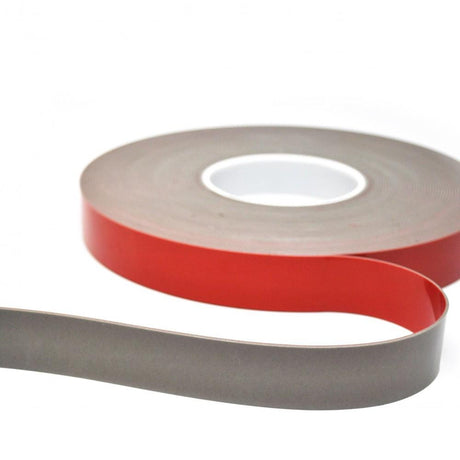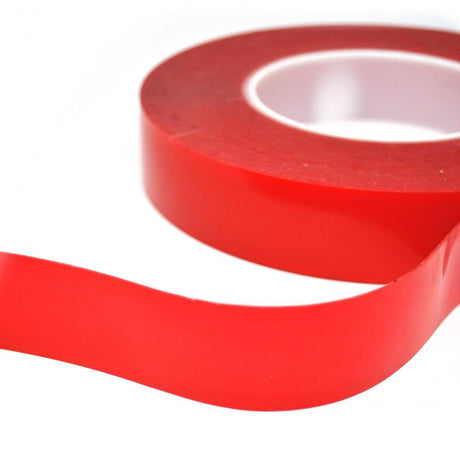Double-Sided Tape
(2 products)- Featured
- Best selling
- Alphabetically, A-Z
- Alphabetically, Z-A
- Price, low to high
- Price, high to low
- Date, old to new
- Date, new to old
FiltersFilter & Sort
Gray High-Bond Double-Sided Tape ~ Silvertape 5341
From $16.80 USDUnit price /UnavailableClear High-Bond Double-Sided Tape ~ Silvertape 5310
From $72.00 USDUnit price /Unavailable
Double-sided tape is an essential adhesive solution used in countless applications, from everyday crafts to heavy-duty construction projects. Our high-bond double-sided tape range is top quality and suitable for many industries and applications. Options come in a Clear VHB tape and Gray VHB tape with various widths and thicknesses. These are double-sided high performance acrylic based adhesive tapes, which are designed for a wide variety of materials with varying levels of surface energy.
These superior high bond industrial strength tapes provide long term holding power and are suited for both interior or exterior applications. They are the perfect products to replace mechanical fasteners like rivets, screws, spot welds, and liquid adhesives.
What is Double-Sided Tape?
Double-sided tape is a type of adhesive tape with adhesive on both sides, making it perfect for bonding surfaces together without the need for visible fasteners. This construction allows it to stick to both the item you're attaching and the surface it’s being applied to. Double-sided tape comes in a variety of materials such as foam, cloth, and plastic, each designed for specific uses and performance levels. For instance, foam-based double-sided tape is ideal for cushioning, while cloth-based tape is more flexible and durable.

Advantages of Double-Sided Tape:
- Strong Adhesion Without Visible Tape: Double-sided tape provides a clean and seamless finish. Because the adhesive is hidden between the surfaces, it’s ideal for projects requiring an invisible bond, such as crafts, displays, or decorations.
- Easy to Apply and Remove: Using double-sided tape is straightforward—just peel, stick, and press. Many commercial-grade tapes are designed to remove cleanly, leaving no residue on most surfaces.
- Versatile for Multiple Surfaces: Double-sided tape works on a wide range of materials, including wood, glass, plastic, and metal. This versatility makes it a popular choice for both temporary and permanent applications.
Disadvantages of Double-Sided Tape:
- Limited Reusability: Unlike hooks or reusable adhesives, most double-sided tapes lose their stickiness after being removed, making them a one-time-use product in many cases.
- Surface Preparation May Be Needed for Optimal Adhesion: For the best performance, surfaces must be clean, dry, and smooth. Dust, grease, or uneven textures can reduce adhesion strength.
The Difference Between Double-Sided Tape and Single-Sided Tape
When choosing between double-sided tape and single-sided tape, it’s essential to understand their unique applications, strengths, and limitations—especially if you're working with commercial-grade adhesives.
-
Adhesion and Strength:
- Double-Sided Tape: Offers strong adhesion on both sides, ideal for bonding two surfaces directly. Commercial-grade double-sided tape excels in industrial settings, mounting signage, or securing heavy materials.
- Single-Sided Tape: Designed for sealing, wrapping, or temporary fixes. It typically adheres on one side, leaving the other exposed for easy handling.
-
Usage Scenarios:
- Double-Sided Tape: Perfect for projects where aesthetics matter, such as displays, crafts, or invisible mounting. It’s commonly used in offices, manufacturing, and construction for a seamless bond.
- Single-Sided Tape: Best for labeling, bundling, or quick repairs where the tape itself is visible.
-
When to Choose Each:
- Use double-sided tape for tasks requiring a hidden bond or heavy-duty adhesion. Commercial-grade versions are especially reliable for demanding applications.
- Choose single-sided tape for simple fixes or tasks where visibility and strength aren’t critical.
How to Remove Double-Sided Tape Without Damage
While double-sided tape is a lifesaver for mounting and crafting, removing it can be tricky without proper care. Follow these steps to avoid damaging surfaces:
Step-by-Step Guide for Removing Double-Sided Tape
- Assess the Surface: Determine the type of surface (glass, metal, wood, or painted wall) to select the right removal method.
-
Soften the Adhesive:
- Use a hairdryer on low heat to warm the tape, loosening the adhesive.
- For glass or metal, apply a small amount of rubbing alcohol or adhesive remover.
- Peel Off Slowly: Gently lift one edge of the tape and pull it off slowly at a 45-degree angle to prevent residue.
-
Clean Residue:
- For stubborn spots, use a soft cloth with rubbing alcohol or a commercial adhesive remover.
- Avoid abrasive tools that may scratch surfaces.
Frequently Asked Questions
Is double-sided tape waterproof?
Yes, some double-sided tapes are waterproof, but it depends on the type and intended use. Commercial-grade double-sided tapes often offer water-resistant or waterproof options designed for outdoor or high-moisture applications. Always check the product specifications to ensure it meets your needs.
What should I do if the tape doesn't stick properly?
If the tape doesn’t stick properly, ensure the surface is clean, dry, and free of dust, grease, or debris. Press the tape firmly to activate the adhesive and allow it to bond for a few minutes before applying weight. If the issue persists, check if the tape is suitable for the specific surface or conditions, such as temperature or humidity.
Is double-sided tape easy to remove?
Yes, double-sided tape can be easy to remove if handled correctly. Using heat (like a hairdryer) or adhesive removers can help soften the adhesive, making it easier to peel off without damaging surfaces. Patience and proper tools, like a plastic scraper, also ensure a smooth removal process.
Does double-sided tape leave residue on surfaces?
Yes, double-sided tape can leave residue on surfaces, especially if it's left for a long time or exposed to heat and moisture. However, some commercial-grade double-sided tape is often designed to minimize residue and can be removed cleanly with proper techniques.
How long does double-sided tape last?
The lifespan of double-sided tape depends on the type, surface, and environmental conditions. High-quality double-sided tape can last for several years if applied correctly to clean, smooth surfaces. However, exposure to heat, moisture, or heavy loads may shorten its durability.
Is double-sided tape better than glue?
Double-sided tape is often better than glue for tasks requiring a clean, mess-free application. It provides immediate adhesion and is easy to remove or reposition. Glue, on the other hand, can be more permanent and may require drying time, but it can bond more securely for heavier or more durable applications. The choice depends on the specific project needs.
Can double-sided tape hold metal?
Yes, double-sided tape can hold metal, but its effectiveness depends on the type of tape and the weight of the metal. Stronger adhesive tapes, like those designed for heavy-duty applications, are better suited for securing metal items. Make sure the surface is clean and dry for optimal adhesion.
Your cart


